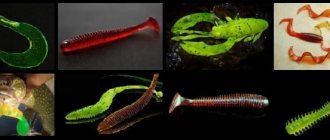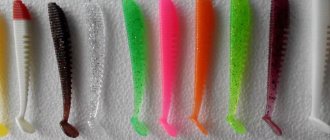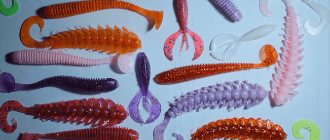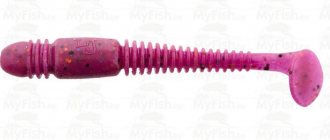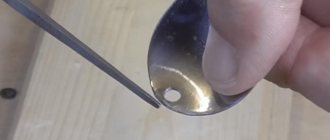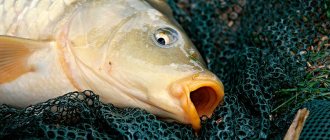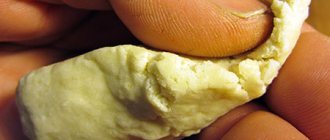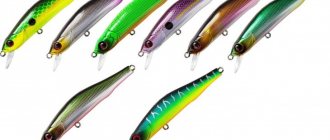Box for wobblers
A box for wobblers and spinners is an indispensable attribute of any self-respecting fisherman.
This fishing box is used to accurately store and easily transport spoons, wobblers and other fish baits. Using this box, the fisherman sorts the baits according to their size and method of use, which greatly facilitates the fishing process and speeds up the search for the spinners and wobblers needed at the moment. For avid fishermen, this box is already a huge, heavy box that takes up a lot of space (usually in a garage or storage room). Before fishing, the necessary baits are moved from the box into smaller boxes that correspond to the time of year, weather conditions at the moment and the type of fish that will be “hunted”.
Storing wobblers
Storing this type of bait requires conditions that prevent them from coming into contact together, leading to the tees getting tangled and causing scratches.
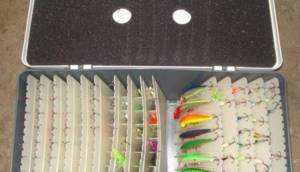
Types of boxes for wobblers
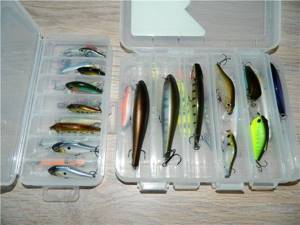
Fishing boxes for baits are:
- universal;
- specialized.
The latter option is sold by shops for anglers and is produced exclusively for storing spinners and wobblers. They may differ in design, number and volume of compartments and other configurations (for example, with removable partitions or double-sided boxes), which take into account the characteristics of a particular type and method of fishing. These boxes are made from high-quality special plastic, which is resistant to mechanical damage and does not react with the material of modern baits.
Not all fishermen have the financial means to spend money on branded boxes. Therefore, they adapt construction and carpentry boxes, food containers, first aid kits and other boxes for them, modifying them to suit their own needs. This approach also has a number of advantages: you don’t need to spend extra money, you can personally modify it and adapt it to your own needs; many of these boxes, especially construction and food boxes, are made of high-quality plastic, resistant to external influences, and designed for use in extreme conditions.
Both branded boxes and homemade boxes are actively used by fishermen; which one to choose depends solely on the wishes of the fishing enthusiast himself.
Specialized box for wobblers
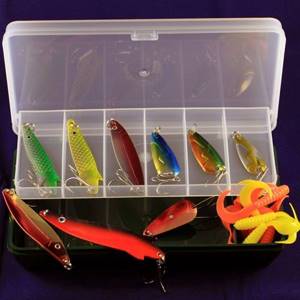
The assortment of this type of box is so large that even fishermen with many years of experience get lost among the options offered.
If you have many types of baits, then large, spacious boxes are ideal for storing them. Such boxes usually have several levels, many pull-out pockets, and there are also models that, like a nesting doll, include smaller boxes.
Large boxes are usually taken by anglers who prefer to troll from a boat. Once installed on board the boat, the desired bait will always be at hand.
Matryoshka boxes are suitable for permanent storage of baits in one place and are not very convenient for transportation. Before fishing, simply select a smaller box with the necessary wobblers and remove it from the main box.
Bait storage
Wobblers and spoons have sharp hooks that can damage other baits. To ensure that active dangerous parts do not harm the bait, wobblers must be placed one in each compartment of the box. It is important that the compartment is slightly larger than the wobbler itself. A double-sided box is often sold on the fishing equipment market; this option is very convenient and compact, which is why we especially love it among spinning anglers.
Homemade bait box
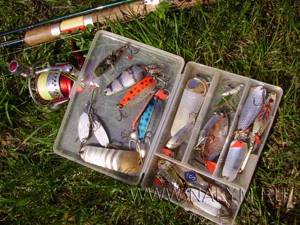
Many people wonder how to make a box for wobblers with their own hands.
For these purposes, you can adapt and remake an ordinary lunch box or food container:
- We select a container of the required size; it is important that its lid does not dangle, but closes tightly;
- The inner part is framed with foam rubber, which will dampen noise during transportation, and it is also very convenient to attach wobblers to it.
Such a budget box for wobblers will save money and give the fisherman the opportunity to design a box to his own taste.
Let's sum it up
Any option is good, and each angler makes a choice in relation to baits and their boxes from his own experience.
DIY box for lures and hooks with a magnetic lock
Hello, dear readers and DIYers! Surely there will be fishing lovers among you. And this difficult task requires many different lures and hooks. In this article, the author of the YouTube channel “Third Coast Craftsman” will tell you how he made a beautiful and practical box for storing them.
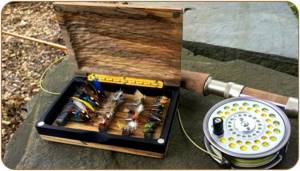
Materials. — Pallet board, ebony ebony — Neodymium magnets — Sandpaper — Furniture hinge — Wood screws — Linseed oil — PVA glue, two-component epoxy glue.
Tools used by the author. — Plane, jointer, chisels, rasp, miter box — Hand plane — milling cutter (you can read about its manufacture in this article) — Clamps — Screwdriver — Rubber spatula, rags — Screwdrivers, square, ruler, pencil, marker. Manufacturing process. The author found some very remarkable pallet boards in his lumber yard, presumably made of maple or balsa wood. Their peculiarity was thin dark fibers that lay in veins in the structure of the wood and create an unusual wood pattern.
Sometimes the material itself inspires the master to create a “masterpiece”... This is what happened in this case. The idea was born to make a neat box for fishing hooks from this seemingly unsightly old wood.

First of all, the master cuts the pallet boards to the length of the future product, using a kind of miter box
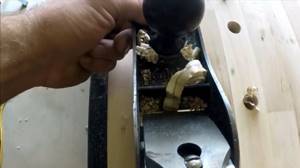
In the same way, using a plane, he removes the weathered layer of wood from the front and back sides of the boards, planing their surfaces and exposing the unusual wood pattern.
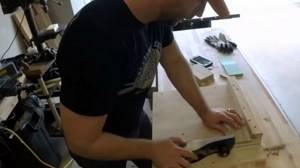
Now the bottom needs to be edged. For this purpose, the author selects Coromandel black (ebony) wood for contrast. The master cuts the edge itself on a circular saw, making 45-degree bevels at the corners.
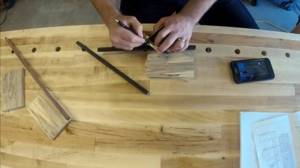
The dark side sits on the glue and is fastened with a rubber band. Excess glue is carefully removed with a spatula.
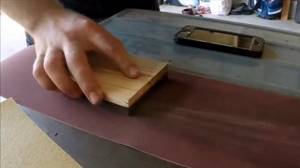
The next stage is the hinges, which should hold both flaps of the box together. It turned out to be not so easy to choose hinges of suitable sizes, because the box is quite small, and the cutouts for the hinges are even smaller. The author chose piano hinges. The only pity is that their full turn was not 180, but 90 degrees.
The author carefully measures the location of the loop, achieving perfect symmetry. Then he marks the future holes and the perimeter of the loop.
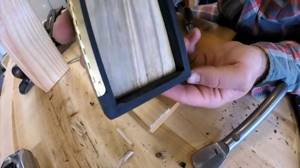
On the second part of the future box (lid), using a marking thicknesser, a notch is made to the required depth under the second side of the loop. At this distance from the edge, a recess is made into which the loop will fit.
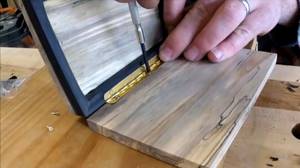
Using a hand plane, the craftsman smoothes the sharp sides and corners of the box and sands it with sandpaper.
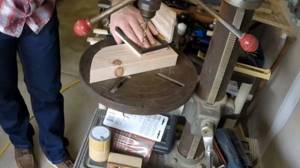
The magnets are attached with two-component epoxy adhesive. Here it is important to maintain the polarity of the magnets in the lid and bottom, otherwise they will repel instead of closing!
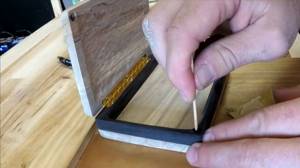
The almost finished product is impregnated with Danish oil, emphasizing the unusual wood grain. You can also use linseed oil and wax. The master applies the oil in a thick layer, spreading it with a rubber spatula. After absorption, the excess is removed with a rag.
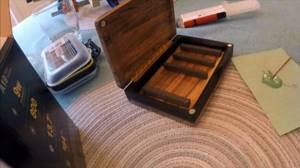
And this is what the finished box looks like. Well, what avid fisherman would refuse such a gift?
Source
Become the author of the site, publish your own articles, descriptions of homemade products and pay for the text. Read more here.
To the fishermen. Double-sided box for wobblers.
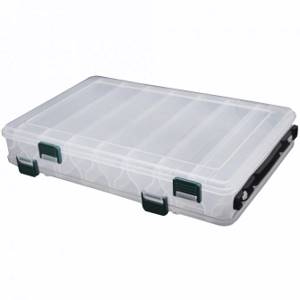
- Price: $7.00 at time of purchase $5
- Go to the store
The lids are attached to the main part with hinges, which will have a positive effect on the shelf life of the box. The box has many holes for ventilation, so the fittings on the baits will not rust. The latches are reliable, they never opened on their own, although along the way they were stuck in a backpack with other boxes.
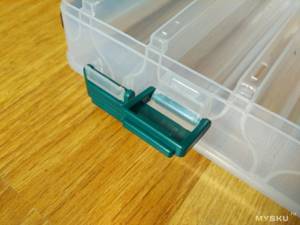
There is a soft handle on one side for easy transportation.
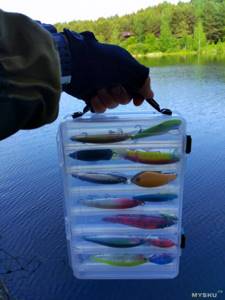
Lure box: whim or necessity?
Where and in what to store spinners is a purely personal matter; for some it is easier to find the right thing among all the chaotically located variety in a fishing box, but for others, order is needed in everything.
- Varieties
- Required parameters
- With your own hands
Of course, a box for spinners is more of a necessity than a whim. Useful and necessary qualities of a container for storing artificial baits include:
- ease of transportation and operation;
- protection of attachments (and sometimes very expensive ones) from various types of damage (breakage, scratching, etc.);
- Minimum waste of time when searching for the right product.
An exclusive version of the box as a source of pride
You can buy an industrial-made charabanc. In any fishing store they are presented in a wide range.
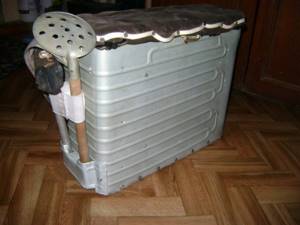
But avid fishermen try not to make such purchases, considering it the lot of beginners. After all, a homemade fishing box for fishing assumes that it will take into account all the preferences and habits of the owner.
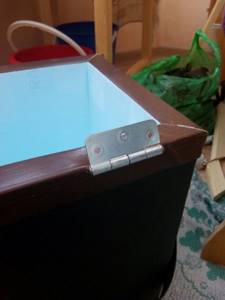
For example, the vertical or horizontal arrangement of the departments, the width of the lid that acts as a seat, and the material from which it is made.
«>
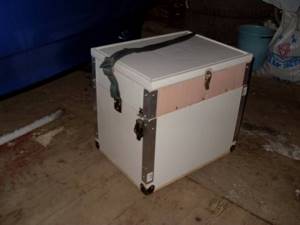
Even such a moment as the height of the compartment for your favorite thermos should also be taken into account!
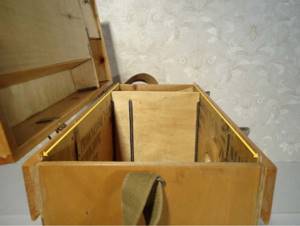
That is why among the many fishermen on the ice it is difficult to find someone with the same boxes. An exclusive version of the charabanc is a source of pride for every fisherman!
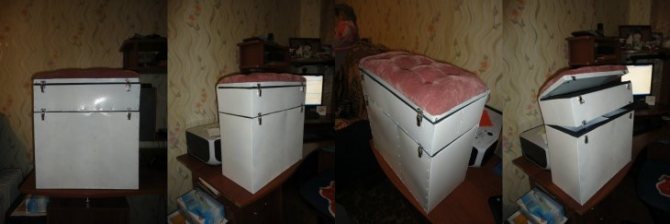
Varieties
The most budget option is all kinds of containers that are often used at home (construction economizers, car and home first aid kits, food containers, etc.).
Construction boxes are most often used, given their diversity not only in appearance and internal design, but also in size, which sometimes plays a decisive role in the choice of a particular accessory. Construction boxes are made of fairly durable plastic; they also contain completely transparent products with a tightly opening and closing lid. Their low cost also attracts consumers. The inside of the box is made in the form of cells and compartments of various sizes. You can also find samples with so-called mobile jumpers, which allow you to install compartments of the required dimensions. And double containers can provide reliable storage of spinners on both sides, which is also convenient and profitable.
Special-purpose fishing boxes are in quite high demand among consumers of such products. Their dimensions are maximally adapted to certain sizes of manufactured baits. Such containers fit perfectly into the pockets of equipment and fishing backpacks. Although their cost is much higher than the same construction suitcases, the comfort is worth it.
So, the following modifications are available for sale:
- Single-sided container with size 18x9 and 10 internal compartments. Used for ultra-light class baits, in particular for shad, fat, minnow wobblers with a length of 35, 40, 50 mm. Each cell can contain 2 baits. If you exceed the recommended number of attachments placed, there is a possibility of tangling the hooks and damaging the coating of the product.
- To store large baits, manufacturers have provided models with internal compartments over 7 cm.
Don't forget about the depth of the cells. On the fishing accessories market, boxes for spinners are presented in a wide range from both domestic manufacturers and well-known global companies. Of course, the cost of fishing tanks from leading manufacturers is many times higher, but the products of lesser-known companies are not much inferior to them in terms of consumer qualities.
Boxes for spinners from Volnix are available in a large assortment and at an affordable price. They are designed for storing small wobblers and other baits. The appearance of the container is quite decent, and the quality of the material is quite reliable.
Types of bait boxes
Fishing boxes for wobblers and spinners can be specialized or general purpose. The first ones are sold in fishing stores and are made directly for storing baits. Their design, configuration and basic parameters are selected taking into account the needs of fishermen; the manufacturer focuses on different fishing methods, their features and the requirements of modern spinning anglers. Such products are made of special plastic, which has the necessary performance properties and does not have a negative effect on baits.
Some fishermen, lacking financial resources, use various construction boxes, food boxes, school pencil cases, and first aid kits to store baits. They can be modified by changing and modifying them to suit specific models of spinners and wobblers. The advantage of this approach is:
- Possibility of purchasing the required box at the lowest possible price.
- You can modify it yourself, taking into account your needs.
- Many general purpose boxes, especially construction economizers and food containers, are made from durable, high-quality polymer material that can withstand harsh operating conditions.
Both options have the right to life. The specific model is determined by the fisherman independently, taking into account the criteria stated above.
Required parameters
When choosing a high-quality box for spinners, first of all you need to focus on the following characteristics:
- Container size - given the constant updating of baits, it is more advisable to purchase a fishing box, if not the largest, then at least a medium one.
- The presence of internal compartments - the ideal option is a large box with many internal compartments and mobile partitions.
- The presence of handles and straps for transportation is such a necessary accessory that allows you to easily carry the box during frequent movements along the shore of the reservoir.
Where is it convenient to store wobblers? Convenient boxes for wobblers and baits
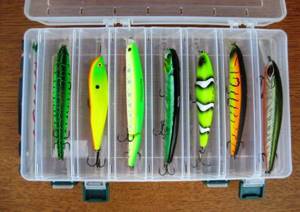
I think every fan of spinning fishing will definitely think about where it is more convenient to store wobblers, twisters and other fishing utensils. In fact, there are a lot of storage methods, you can buy tool boxes and simply store wobblers in compartments, but this method is not very convenient, because the hooks get tangled and when you get the right wobbler, you end up with several at once.
However, there are also special fishing boxes that can be divided into two types, these are boxes with adjustable partitions and double-sided boxes with triangular compartments, each of these types of boxes is convenient in its own way.
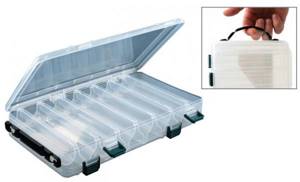
With your own hands
You can make a box for storing spinners yourself, from scrap materials. For this you will need:
- a transparent plastic food container with a tight-fitting lid;
- foam strip for edging;
- self-tapping screws for fixing the edging.
Inside the plastic container around the entire perimeter there is a edging (foam strip 1x1 cm). To increase the versatility of a homemade product, you can additionally fix a similar strip in the middle part (across) of the container. Lures in such a box cling to a strip of foam using hooks. It is better to purchase a container depending on the size of the bait. To ensure that the strips are held securely, they can be secured through the walls of the container with small self-tapping screws. For convenient transportation, the box is equipped with handles.
For the second option you will need:
- 2 organizers for hardware;
- adhesive-based sealant (for insulating windows);
- a piece of cuff elastic;
- automotive double-sided tape;
- scissors.
First you need to cut the seal to the size of the existing cells. Next, you need to remove the protective film from the strips and glue them to the bottom of the cell. Double-sided tape should be attached to the bottom of the organizer. Then you need to remove the protective layer and glue the elastic band to the bottom of the same organizer. After this, you need to remove the protective layer from the second organizer, and then connect (glue) them together with the bottom. The box for storing spinners and other baits is ready for use.
Thanks to the elastic band, it can be attached to both the hip and the belt. If you use a belt or something with a clasp instead of an elastic band, then carrying a bait box will become even more convenient and reliable.
A box for storing spinners is a very convenient thing, which makes it possible to reduce the time spent searching for the desired bait and ensures the safety of the contents.
Video about bait storage boxes:
Video about the “mysterious” box:
Painting a winter fishing box
If you paint a homemade winter foam box in a color that is noticeable in the snow, you can go fishing tomorrow. I can advise you the same way about painting a homemade plywood box.
And, if you paid attention to this, metal corners are glued to the lower corners of my fishing foam boxes and then secured with short screws.
To increase strength, all walls of the winter fishing box can be coated with PU-2 glue or epoxy resin before painting. Just keep in mind that the glue is very difficult to process mechanically, so impregnation should be done carefully.
By the way: You can take the dimensions of a plywood ice fishing box from a foam fishing box. Open the link below.
START OF TOPIC:
Homemade foam box for ice fishing
***
To the fishermen. Double-sided box for wobblers.
- Price: $7.00 at time of purchase $5
- Go to the store
The lids are attached to the main part with hinges, which will have a positive effect on the shelf life of the box. The box has many holes for ventilation, so the fittings on the baits will not rust. The latches are reliable, they never opened on their own, although along the way they were stuck in a backpack with other boxes.
There is a soft handle on one side for easy transportation.
Overall, I liked the box; it is compact, roomy and reliable.
The product was provided for writing a review by the store. The review was published in accordance with clause 18 of the Site Rules.
- 19 July 2021, 11:57
- author: Quattro
- views: 8284
- InSAn
- 19 July 2021, 12:02
- Quattro
- 19 July 2021, 12:05
- InSAn
- 19 July 2021, 12:36
I don’t remember - it was a long time ago.
PS: I am from Ukraine. Here RU. RMs are not sent
